Hiking is a great pastime for many, especially in Calgary where there are countless beautiful trails to explore and discover. It’s a great way to get physical activity in, connect with others, and to spend some time in the outdoors. However, many people are plagued with knee pain that gradually develops as they go up, or even more so when they go back down, on bigger hikes. Some will end up in their doctor’s office, get sent for x-rays that show degenerative changes in their knee joint, get labeled as having arthritis, and think that they are through. Never mind the fact that some studies have shown that 85% of asymptomatic (pain-free) adults will have SOME degenerative change if you x-ray their knees.
It doesn’t have to be this way! Most people with knee pain while hiking can get to being pain-free with just a little bit of corrective exercise. This is because most of the pain we experience in our knees when hiking up or down inclines, or even while going up and down the stairs at work or home, is usually due to muscular imbalances along the pelvis, hip, and ankle which exert increased stress on the knee. Its kind of like driving your car with the wheels out of alignment—signs of stress are going to start to show up in other areas. Usually, once imbalanced are mitigated, pain improves, and often irrespective of wear and tear in the joint.
In this post, let’s outline two of the more common causes of knee pain with hiking. These causes are often seen at the same time; one or both may apply to you. We will then provide you with basic exercises to perform a few times a week to get you started on working towards enjoying your summer outside to its fullest.
1. Overworked quadriceps
Pain in the front of your knee, or behind your kneecap? You might just be overloading your quadricep muscles. These quadriceps, or quads, are four muscles run down along the front of your thigh. They meet just above the kneecap to form the quadriceps tendon, which your patella (kneecap) sits inside. From here, the quad tendon forms the patellar tendon, which inserts into the front of your tibia (shin bone).
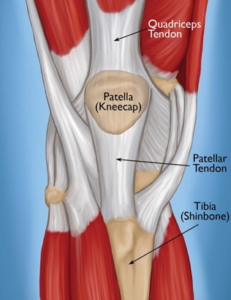
Hiking up and down hills is very taxing on your quads if you aren’t a regular hiker, especially as we walk downhill. A lot of people don’t realize that as your muscles get fatigued, they tend to get tense. As these muscles tense, and we continue to bend our knee against this tension, tensile stress starts to develop in the tendons and across the knee cap that sits inside, causing soreness, pain, and inflammation. The quadricep tendon or patellar tendon may become sore, or the patella sitting in the middle of these tendons can also become compressed against the rest of the knee joint, causing extra friction and irritation as your kneecap moves through its grove every time your knee bends. If your knee cap grinds when you bend your knee, this is often why.

Having excessive anterior pelvic tilt or poor core control makes us even more prone to overloading our quads. People often develop excessive anterior pelvic tilt because of underutilization of our deep core muscles (i.e. transverse abdominus, rectus abdominus). This may develop from spending excessive amounts of time sitting or following pregnancy (especially following C-sections). When we underutilize these core muscles, our pelvis tilts forward, causing our center of gravity to shift forward. With this shift, our quads have to work in overdrive to support our bodies, and we under-utilize the glutes and hamstrings.
Release tension in our quads with foam rolling:
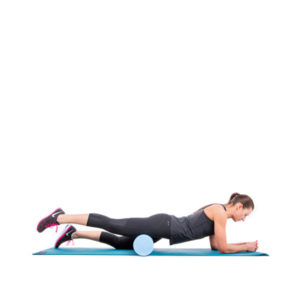
Place your foam roller on the floor and lie on your stomach with the front of one thigh over the foam roller and the other leg on the floor for support.
Roll the entire front of the thigh from the top of the hip to the top of the kneecap in an up and down motion.
Maintain your abs tight and proper low back posture during the exercise.
Repeat for 1-2 minutes as tolerated on each leg.
Strengthen quads with exercises such as step-ups and step-downs:
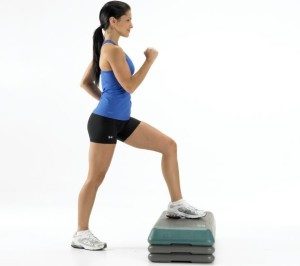
Stand in front of a step.
Step upwards onto the step.
Step down as slowly as you can.
Make sure your knee tracks over the front of your foot and doesn’t collapse inwards. Try not to over-arch your low back.
Repeat 2-3 sets of 15-20 repetitions as tolerated.
*Start with a lower step, increasing the height as tolerated for more of a challenge.
Transverse Abdominus Activation
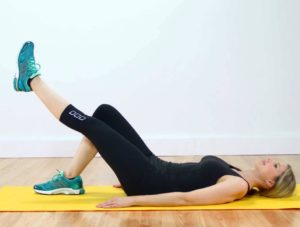
Lie on your back with your knees bent.
Engage your core: draw your front ribs and navel towards our spine, and flatten your low back slightly towards the floor.
Maintain steady abdominal breathing while you extend one leg without touching the ground, keeping your back from arching off the floor and your ribs and belly from flaring out.
Return slowly to the initial position and repeat with the other leg.
Inhale as you straighten and lower your leg, exhale as you bring it back.
Repeat as able for 10-15 repetitions per leg, providing it is pain-free and with good.
- Under-utilization of muscles at the hip
Pain on the outside or inside of your knee? Your gluteal (your butt!) muscles keep your femur (thigh bone) in proper alignment while you walk, squat, kneel, and bend. This is especially true with walking up and down hills when hiking. These muscles are often underactive in people with knee pain. Underactivity in these muscles may be due to sitting for long periods during the day with these muscles in a somewhat stretched position, or if we didn’t play or participate in a lot of physical activity while our bodies were growing and developing. These muscles also often get overlooked when we work out in the gym; traditionally, we do lots of exercises that move our legs forward and backward (i.e. squats, deadlifts, knee extensions, knee curls). However, our hips and thigh bones also need strength and control with moving side to side (abduction, adduction) and rotation, and many people often overlook exercising our hips in these directions.
When we lack control of these muscles, our femur (thigh bone) tends to collapse and rotate inwards, especially with walking downhill. This puts a lot of extra stress on the inside of the knee, which may become painful. Underactive gluteal muscles may also cause us to overload the iliotibial band (IT band) and/or vastus lateralis (one of the outer quad muscles). These tissues also become tense from overloading and may then cause irritation along the outside of the knee.
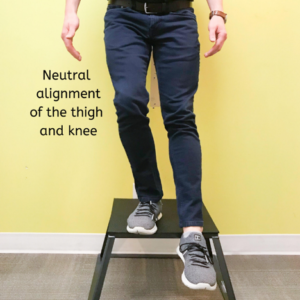
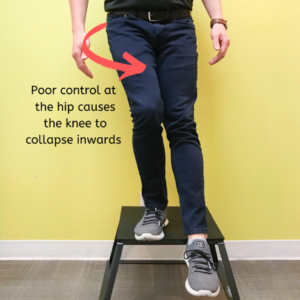
The Solution:
Release tension on the outer quads and glutes:
Foam Roll Outer Quads/IT Band
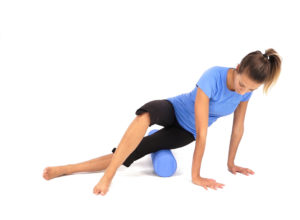 Place your foam roller on the floor. Take a side position with the outside of the thigh over the foam roller and your other leg in front for support.
Place your foam roller on the floor. Take a side position with the outside of the thigh over the foam roller and your other leg in front for support.
Roll the entire outside of your leg from your pelvis to your knee in an up and down motion. Avoid rolling over your outer hip bone.
Maintain your abs tight and proper low back posture during the exercise.
Repeat for 1-2 minutes as tolerated on each leg.
Foam Roll Glutes
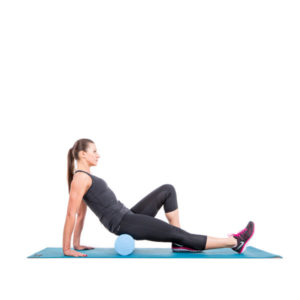 Place your foam roller on the floor and sit on it.
Place your foam roller on the floor and sit on it.
Lean to one side, having the foot of that side over the opposite knee in a figure 4 position.
Roll along your buttock in a front to back motion from our lower back to the bottom of the buttock. Avoid rolling over your sit bones.
Maintain your abs tight and proper lower back posture during the exercise.
Repeat for 1-2 minutes as tolerated on each leg.
Gain better control of your hip musculature:
Knee to Wall Glute Activation
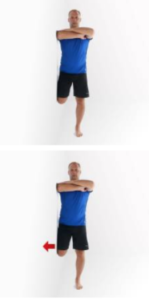
Stand on one leg beside a wall with the other leg bent and touching the wall.
Have the standing foot facing forward and your knee cap aligned with your second toe.
Push your other knee against the wall without twisting or leaning to the side.
Hold for 10 seconds
Relax and repeat on each side 3-5 times.
Lateral stepping with Band
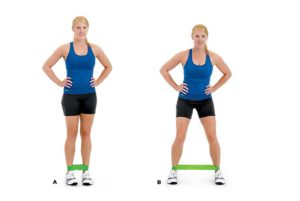 Place a mini-band around the thighs, just above the knee or around the lower leg near the ankle.
Place a mini-band around the thighs, just above the knee or around the lower leg near the ankle.
Hop side to side as quickly as you comfortably can.
Keep the band taut during all the duration of the movement.
Keep the back straight. Keep the toes pointing forward at all time.
Repeat as tolerated for 2-3 sets of 15-20 repetitions on each side.
When to see your physiotherapist:
This article is not an exhaustive resource on knee pain; it is intended to give a basic rundown of two common causes that I see most often in my practice. The exercises provided are just examples of some ways that we can manage these imbalances—some patients may need to start with a gentler routine, while others will require more advanced exercises to meet their needs. Other mechanical factors may be at play, including but not limited to poor ankle mobility and/or poor control of the muscles of the foot and ankle. Furthermore, not all knee pain is due to mechanical stress. We are all unique, with different physical shapes, builds, experiences, and so on. A full assessment with a physiotherapist will best determine which factors apply to you and rule out other possible contributors to your pain. Every patient should be provided a tailored corrective exercise program unique to their circumstances and presentation.
Some signs that you should stop hiking and seek professional care:
- When the pain feels sharp as opposed to a dull ache
- If pain starts to compromise your gait (i.e. walking with a limp)
- When your knee feels unstable, loose, or gives way
- When there are signs of inflammation (swelling, throbbing, redness, warmth to the touch)
- You see no change in your knee pain after practicing these exercises for 2-3 weeks.
Questions? Contact Mark at mark@ascenthealth.ca for help in getting your body back to its best and back to doing the things you enjoy. Have a wonderful summer!
